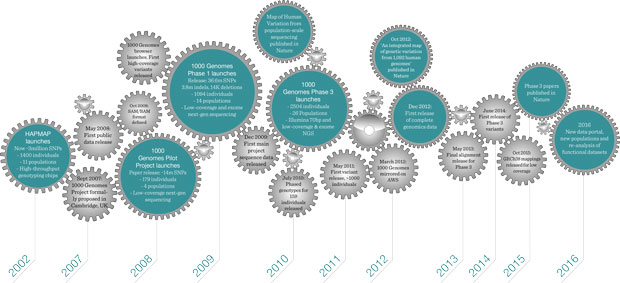A catalogue of large-scale genetic changes around the world
In a nutshell
- Missing a gene may not be a big deal
- Catalogue will help to focus search for genetic causes of disease
- Part of 1000 Genomes Project, which examined genetic variation in over 2500 human genomes
Missing a gene may be less problematic than you’d think. This is one of the conclusions that emerge from the most extensive catalogue of structural variations – changes in large sections of a person’s DNA sequence – to date. Created by researchers at the European Molecular Biology Laboratory (EMBL), the University of Washington, and collaborators, this reference catalogue shows how these large-scale genetic alterations vary in populations across the globe, and will help guide future studies of genetics, evolution and disease. The work, carried out with the 1000 Genomes Project, is published today in Nature, alongside a paper on the project’s final outcomes.
“When we analysed the genomes of 2500 people, we were surprised to see over 200 genes that are missing entirely in some people,” says Jan Korbel, who led the work at EMBL in Heidelberg, Germany.

“Genome sequencing is beginning to be used for diagnostic purposes, and when doctors see that a piece of the genome is missing in a patient, there’s a temptation to tie that to a diagnosis,” says Evan Eichler, who led the work at the University of Washington. “We can now let clinicians know that there are certain genes that really should not be used to try to explain diseases in this way.”
Many studies have implicated broadly-defined regions of the genome in common diseases. Interestingly, the large-scale changes catalogued by Korbel, Eichler and colleagues frequently occur in such disease-linked regions, implying that these structural variations are probably common risk factors for disease.
“Our work reveals that structural variations are often likely to have functional consequences,” says Oliver Stegle, whose team at EMBL’s European Bioinformatics Institute (EMBL-EBI) took part in the study. “So we can now advise on what researchers should be looking for when they’re trying to understand the genetic causes of a certain condition.”
In keeping with existing knowledge about genetic diversity, the team found that the structural variations present in people’s genomes depend on where in the world they come from. In European and Asian populations, structural variations made up a greater proportion of changes to the genome than in African populations, while African genomes harboured a much greater diversity overall.
The scientists also showed that structural variations often have greater effects than changes in single letters of the genome (SNPs). And thanks to technological developments, they were able to catalogue new types of structural variation that previous studies had been missing.
“We were astonished to find variations which cannot be accounted for by the processes that researchers believed usually alter the genome,” says Korbel, “it will be interesting to find out how these structural variations do arise.”
The work was part of the 1000 Genomes Project, which examined genetic variation in over 2500 human genomes, with all data made available online immediately as it emerged. Thanks to this public repository, managed at EMBL-EBI, other scientists have already begun to access and make use of the data.
“We’re extremely grateful to everyone who donated their DNA to the project and made it available to use openly for research that can enable future biomedical advances,” says Paul Flicek, who is in charge of the public repository of the data at EMBL-EBI. “Their generosity has not only enabled this project, but will continue to bear fruits in years to come, as many studies will make use of the data.”

Source article
Sudmant, P.H., Rausch, T., Gardner, E.J., Handsaker, R.E., Abyzov, A., Huddleston, J., Zhang, Y., Ye, K. et al. ‘An integrated map of structural variation in 2,504 human genomes.’ Nature, 1 October 2015. DOI: 10.1038/nature15394
The 1000 Genomes Project Consortium. ‘A global reference for human genetic variation.’ Nature, 1 October 2015. DOI: 10.1038/nature15393
POLICY REGARDING USE
Press and Picture Releases
EMBL press and picture releases including photographs, graphics, movies and videos are copyrighted by EMBL. They may be freely reprinted and distributed for non-commercial use via print, broadcast and electronic media, provided that proper attribution to authors, photographers and designers is made.
This article was originally published on EMBL News
